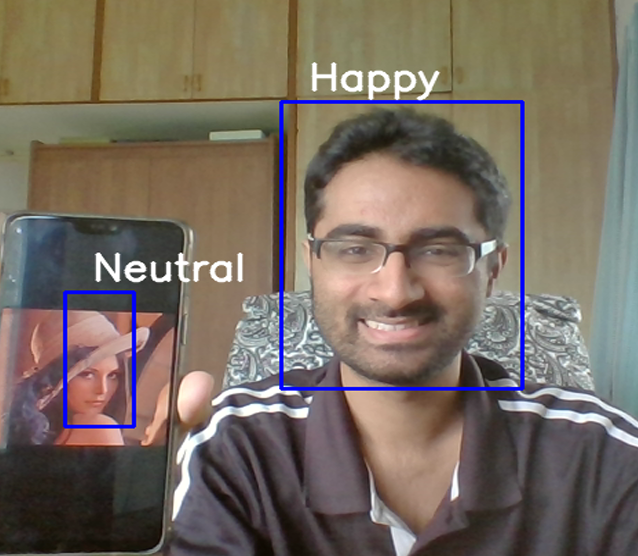This project aims to classify the emotion on a person's face into one of seven categories, using deep convolutional neural networks. This repository is an implementation of this research paper. The model is trained on the FER-2013 dataset which was published on International Conference on Machine Learning (ICML). This dataset consists of 35887 grayscale, 48x48 sized face images with seven emotions - angry, disgusted, fearful, happy, neutral, sad and surprised.
- Python 3.6, OpenCV 3 or 4, Tensorflow, TFlearn, Keras
- To install the required packages, run
pip install -r requirements.txt.
There are two versions of this repository - written using TFLearn and Keras. Usage instructions for each of these versions are given below. Both versions work equally well if you want to detect emotions only one face in the image. However, I suggest you use the keras implementation, since it provides better results if there is more than one face.
-
Clone the repository and download the trained model files from here, extract it and copy the files into the current working directory.
-
To run the program to detect emotions only in one face, type
python model.py singleface. -
To run the program to detect emotions on all faces close to camera, type
python model.py multiface. Note that this sometimes generates incorrect predictions. -
The folder structure is of the form:
TFLearn:- emojis (folder)
model.py(file)multiface.py(file)singleface.py(file)model_1_atul.tflearn.data-00000-of-00001(file)model_1_atul.tflearn.index(file)model_1_atul.tflearn.meta(file)haarcascade_frontalface_default.xml(file)
-
Download the FER-2013 dataset from here and unzip it inside the Keras folder.
-
If you want to train this model or train after making changes to the model, use
python kerasmodel.py --mode train. -
If you want to view the predictions without training again, you can download my pre-trained model
(model.h5)from here and then runpython kerasmodel.py --mode display. -
The folder structure is of the form:
Keras:- data (folder)
kerasmodel.py(file)haarcascade_frontalface_default.xml(file)model.h5(file)
-
This implementation by default detects emotions on all faces in the webcam feed.
-
With a simple 4-layer CNN, the test accuracy stopped increasing at around 50 epochs at an accuracy of 63.2%. The top accuracies in the 2013 Kaggle competition for this were 71.16%, 69.27%, 68.82%, 67.48%.
-
First, we use haar cascade to detect faces in each frame of the webcam feed.
-
The region of image containing the face is resized to 48x48 and is passed as input to the ConvNet.
-
The network outputs a list of softmax scores for the seven classes.
-
The emotion with maximum score is displayed on the screen.
-
"Challenges in Representation Learning: A report on three machine learning contests." I Goodfellow, D Erhan, PL Carrier, A Courville, M Mirza, B Hamner, W Cukierski, Y Tang, DH Lee, Y Zhou, C Ramaiah, F Feng, R Li,
X Wang, D Athanasakis, J Shawe-Taylor, M Milakov, J Park, R Ionescu, M Popescu, C Grozea, J Bergstra, J Xie, L Romaszko, B Xu, Z Chuang, and Y. Bengio. arXiv 2013.


